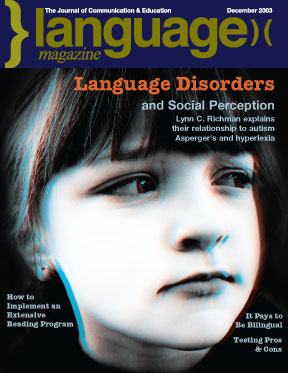Ya Talkin’ About Me?

The way we speak is important — our dialects and accents reveal cultural and historical information about us and our heritage in an almost subliminal way. Nowhere is this more evident than in the United States, where waves of immigrants from all over the world in combination with internal demographic shifts have produced varieties of American English that reflect the country’s cultural mosaic. Over the past four years, distinguished contributors to Language Magazine have worked to document this information through regular articles highlighting the rich diversity of North American speech. These articles have generated great interest — not only within linguistic circles but among the general public — demonstrating the fascination that we all have about the way that we and those around us speak.
Edited by Dr. Walt Wolfram, the William C. Friday Distinguished Professor at North Carolina State University, the Language Magazine dialects series has enjoyed the attentions of the mainstream press. Last month, the New York Times ran a front page story (“Scholars of Twang Track All the ‘Y’Alls’ in Texas”, 11/28/03) inspired by November’s feature on Texan English by Guy Bailey and Jan Tillery (“The Lone Star State of Speech”).
The series has also spawned related projects — the articles are being compiled into a book, Voices of American English, which is due for publication next year by Blackwell Publishing. The producers of the McNeill-Lehrer Newshour are working with Dr. Wolfram and other linguists to produce a two-hour television documentary entitled Do You Speak American? to be broadcast at a primetime slot on PBS in 2004. The documentary will be supported by a DVD and a web site where articles from Language Magazine will appear.
The obvious public interest in American dialects and other linguistic issues should be an encouragement to all those who are involved in language teaching and education who realize the importance of language to society on many different levels. Although this significance rarely receives proportionate media coverage unless it is linked to a controversial issue such as immigration or minority rights, it is obvious that language is the prerequisite for communication — and we are supposed to be in the age of global communication — yet far more airtime is devoted to the technology transporting the words than to the delivery of the words themselves. Maybe this imbalance will now start to be corrected.
Dr. Wolfram has worked tirelessly to secure the contributions of experts to cover regional dialects and also to ensure that the series covered the major variations of American English. I, on behalf of the readers of Language Magazine, would like to take this opportunity to thank him and all of our marvelous contributors for their hard work.
Everyone at Language Magazine would like to wish our readers Happy and Peaceful Holidays whatever your faith, whatever your language, and however you speak it.
IN THIS ISSUE:
Testing: ‘Two Teachers and Their Tests’
Lori Langer de Ramirez recounts her own experiences of testing
Special Education: Integrating Language Disorder and Social Perception
Lynn C. Richman explains the relationship of language disorders to autism, Asperger’s and hyperlexia
When Pooh Won’t Do
Ellen Notbohm suggests literacy startegies for children with autism
Reading: Extending the Gift of Reading
Rob Waring explains how to set up an Extensive Reading program
Bilingual Education: It Pays to Be Bilingual
Workplace rewards for multilingualism
Electronic Education:
Lessons for the one-computer classroom
Dialects:
Jim Fitzpatrick sounds out Boston


